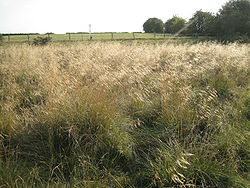Deschampsia cespitosa
Deschampsia cespitosa, commonly called tufted hairgrass, is a native perennial, tussock- forming grass. It is also called Beringian grass.
Synonyms:
- Agrostis caespitosa (L.) Salisb.
- Aira alpicola (Rydb.) Rydb.
- Aira ambigua Michx.
- Aira aristulata Torr.
- Aira caespitosa Muhl.
- Aira cespitosa L.
- Avena caespitosa (L.) Kuntze
- Campella caespitosa (L.) Link
- Deschampsia alpicola Rydb.
- Deschampsia ambigua P. Beauv. ex B.D. Jacks.
- Deschampsia andina Phil.
- Deschampsia biebersteiniana Schult.
- Deschampsia caespitosa (L.) P. Beauv.
- Deschampsia caespitosa ssp. genuina (Reichenb.) Volk.
- Deschampsia cespitosa var. confinis Vasey ex Beal
- Deschampsia cespitosa ssp. genuina (Reichenb.) Volk.
- Deschampsia cespitosa var. strictior Kurtz
- Deschampsia confinis (Vasey ex Beal) Rydb.
- Deschampsia pungens Rydb.
- Podionapus caespitosus (L.) Dulac
Contents
Taxonomy
- Kingdom Plantae – plants
- Subkingdom Viridaeplantae – green plants
- Division Tracheophyta – vascular plants
- Subdivision Spermatophytina – seed plants,
- Infradivision Angiospermae – flowering plants
- Class Magnoliopsida
- Superorder Lilianae – monocotyledons
- Order Poales
- Family Poaceae – grasses
- Genus Deschampsia P. Beauv. – hairgrass
- SpeciesDeschampsia cespitosa (L.) P. Beauv. – tufted hairgrass
Description
Tufted hairgrass is a densely cespitose cool-season native perennial bunchgrass. Culms are hollow, slender, erect, and 8 to 48 inches (20-120 cm) in height. Abundant leaves form basal tufts; blades are 0.8 to 13 inches (2-33 cm) long and 0.04 to 0.16 inch (1-4 mm) wide. The inflorescence is generally a loose, open panicle, though occasionally narrow and contracted; it is 4 to 12 inches (10-30 cm) long. Branches are whorled, hairlike, and spikelet-bearing near their tips. Spikelets are two- to occasionally three-flowered. Lemmas are awned toward the base. The fruit is a caryopsis.
Bloom Period
Blooms in June, fruit ripens through summer and fall.
Distribution
Transcontinental Canada, s. to NC, WV, Great Lakes, ND, mts. of NM, AZ & CA
Habitat
Deschampsia cepitosa occurrence is circumglobal, extending throughout cooler regions of the northern Hemisphere. In Oregon and Washington, sites with tufted hairgrass include seasonally wet soils in low lying areas of the western interior valleys, tidal mudflats and estuarine plant communities near the coast, poorly drained fields, and moist mountain meadows. It can form nearly pure stands in wet or intermittently flooded areas. The species is highly variable.
Occurs in fine, medium and coarse soils – sandy loam, sandy clayey loam, silty loam, loam, loamy clay, and clay. Tufted hairgrass growth is rated fair on sandy loam and good on loam and clayey loam.
Uses
Tufted hairgrass is frequently grazed by bears. Sitka black-tailed deer and feral horses consume tufted hairgrass. Larval host and/or nectar source for Umber Skipper. Attracts birds.
First Nations people report that seeds of Deschampsia species were eaten by indigenous Californians.
Propagation
Can be very aggressive. Leave room to spread or control in place. Doesn't tolerate transplanting unless well-rooted (S. Bastin, pers. comm.).
Photo Gallery
- ==References==
- ===Seed===
- '''Abbreviation:''' DECE
- '''Average Measurement with husk/awn:''' 3.4 x 0.8 x 0.8
- '''Average Measurement without husk/awn:''' 1.8 x 0.6 x 0.6
- '''Measurement Range with husk/awn:''' L: 2.5 – 4.5, W: 0.5 – 1, D: 0.6 – 1
- '''Measurement Range with husk/awn:''' L: 1.5 – 2, W: 0.5 – 0.75, D: 0.5 – 0.6
- ====Features====
- '''Shape:''' Seed narrow at hilum and opposite apex, rounded in the middle.
- '''Additional Structures:''' Lemma thin, and have several nerves running across them. Awn originates from the hilum and is about 1 ½ times the length of the seed body. Hilum bearded with feather like appendage. Palea also thin.
- '''Color:''' Tan palea and lemma, awn slightly darker brown. Inner seed red-brown, and somewhat transparent.
- '''Surface:''' Seed finely longitudinally striate and lustrous. Awn finely barbed.



